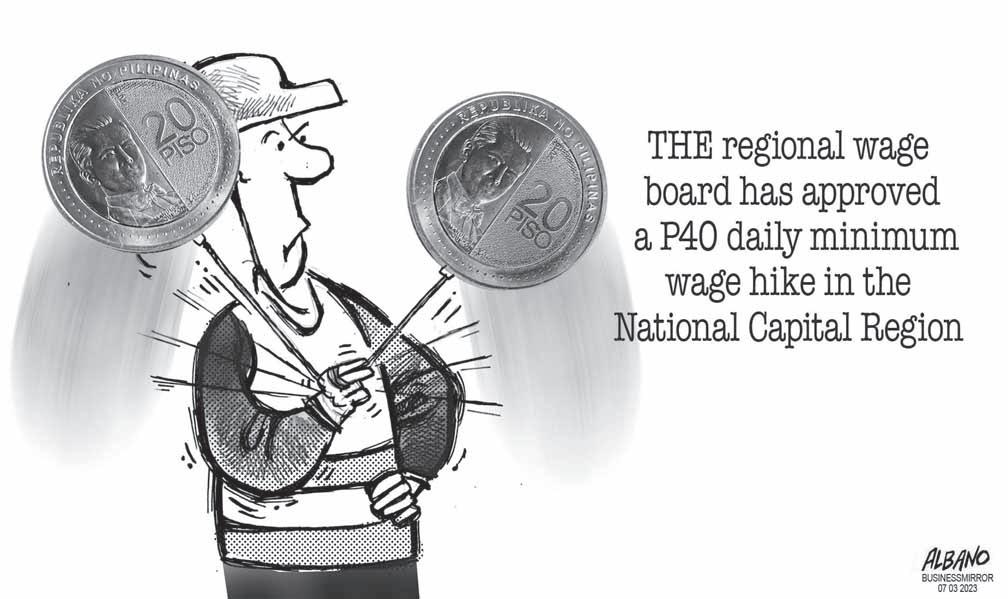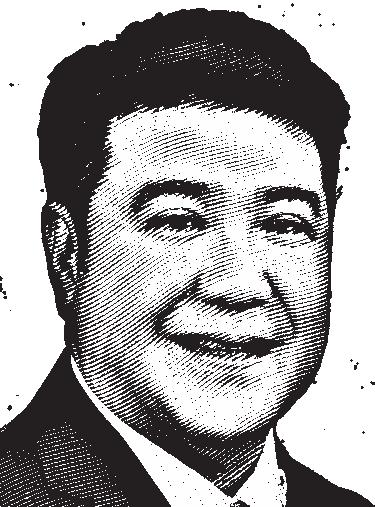
8 minute read
editorial US sanctions will help create BRICS currency
Goldman Sachs chief economist Jim o neill coined the acronym BRIC in 2001—for Brazil, Russia, India, and China—to highlight these countries’ rapid economic expansion. Eight years later, the four countries established BRIC as a formal organization. The bloc became BRICS in 2010 when South africa was admitted.
To ramp up their bid for stronger global influence, BRICS countries are planning to increase membership. Reports said this is one of the major agenda in the August 22 to 24 summit of BRICS heads of state in Johannesburg, including the plan to create a BRICS currency.
“BRICS has acquired a very important stature in the world, with many countries across various continents of our world seeking to be part of it,” said South African President Cyril Ramaphosa.
China’s big agenda is to have all BRICS members back up the political diplomacy it has pursued in several parts of the world. For example, China achieved a huge diplomatic coup in March when it unveiled a rapprochement between longtime US ally Saudi Arabia and US target Iran that it had been quietly working on for months.
That breakthrough has already resulted in some valuable steps toward deescalation in the Middle East. It also drew the two countries and the United Arab Emirates, a key Saudi ally, closer to the non-US trading system being established by BRICS. In June, the foreign ministers of the three countries attended the BRICS meeting in Cape Town. There’s a strong possibility that these three countries will be among those admitted to full membership of BRICS in August.
Pundits said Saudi Arabia’s accession to BRICS would bolster Crown Prince Mohammed bin Salman’s attempts to diversify his nation’s economy, an effort that has brought it much closer to Russia and China in recent years. China is the kingdom’s most important oil customer, while Saudi relies on relations with Russia to help prop up crude prices through Opec+.
Other countries that reportedly expressed interest in joining BRICS include Afghanistan, Bangladesh, Belarus, Comoros, Cuba, the D.R. Congo, Gabon, Guinea-Bissau, Kazakhstan, Nicaragua, Nigeria, Pakistan, Senegal, Sudan, Syria, Thailand, Tunisia, Turkey, Uruguay, Venezuela, and Zimbabwe.
The founding impetus for the BRICS was to build economic coordination among its members. This thrust is expected to come into full play in their August summit when attending heads of state will start discussing the creation of a BRICS currency.
Some financial analysts said the creation of the euro in 1999 is a viable model for the proposed BRICS currency. However, this would require the establishment of a new central bank and an agreement among the BRICS nations to phase out their own sovereign currencies.
Central to the BRICS plan to establish a new reserve currency is the US trade war with China, as well as US sanctions on China and Russia. After Russia attacked Ukraine, Russian officials have been championing de-dollarization to ease the pain from sanctions, which prevented Russian banks to use SWIFT, the global messaging system that enables bank transactions. The West also froze Russia’s $330 billion in reserves last year.
Part of the shift away from the dollar is being orchestrated by China. President Xi Jinping is seeking to carve out a bigger role for the yuan in the global financial system, and his government has made expanding the currency’s use abroad a priority.
Mihaela Papa, a co-investigator on the Rising Power Alliances research project, said: “A BRICS version of the euro is unlikely for now; none of the countries involved show any desire to discontinue its local currency.” But she explained that building blocks for this already exist. “In 2010, the BRICS Interbank Cooperation Mechanism was launched to facilitate cross-border payments between BRICS banks in local currencies. BRICS nations have been developing ‘BRICS pay’—a payment system for transactions among the BRICS without having to convert local currency into dollars.”
The potential impact of a new BRICS currency on the US dollar remains uncertain, with experts debating its potential to challenge the dollar’s dominance. However, if the bloc succeeds in creating a BRICS currency, and this will stabilize against the dollar, it could weaken the power of US sanctions, leading to a further decline in the dollar’s value, which would pose significant implications for the global economy.
Working and learning with AI
Rising Sun
Th ERE are valid reasons why some people are afraid of a I because, in fact, according to the organization for Economic Cooperation and development (oECd), an estimated 1.1 billion jobs could be “radically transformed” by technology in the next 10 years. a report from the World Economic Forum states that by 2027, 43 percent of work tasks will be automated. It’s easy to see why people should invest in reskilling and upskilling, while there is still time.
It’s good to ask if the Philippines is spending and doing enough to promote adult learning and future-ready education. Needless to say, if we are not prepared, our GDP will suffer. If we insist on using outdated learning systems, our workforce will not be able to secure the jobs of the future. This will not only affect individual livelihoods but also the country’s economy as a whole.
Elsewhere, intense preparations are underway. For example, a group of 350 organizations is working together, under the WE Forum reskilling program, to make sure that 1 billion people will have better education, skills, and economic opportunities by the year 2030. This effort started early, before the pandemic hit in 2020. It’s a huge task being carried out by 64 CEOs, 32 ministers from 16 countries, and organizations such as Coursera, Infosys, The Lego Foundation, LinkedIn, UNICEF, and hundreds of other groups. It’s a Reskilling Revolution that is being pushed forward by business members, chief learning officers, online learning providers, labor unions, NGOs, education practitioners, and philanthropic organizations.
It’s good to ask if the Philippines is spending and doing enough to promote adult learning and future-ready education. Needless to say, if we are not prepared, our GDP will suffer. If we insist on using outdated learning systems, our workforce will not be able to secure the jobs of the future. This will not only affect individual livelihoods but also the country’s economy as a whole.
It would be extremely beneficial for our local labor force if we are part of global efforts such as this one and if our public and private institutions are creating similar opportunities to accelerate the reskilling and upskilling of our own workforce. There is quite a big skills gap to close and it will be tragic if we are to one day wake up and realize that we’ve been left behind. Collaboration with other nations will also offer great opportunities for sharing ideas and best practices.
Teaching and learning strategies must be evaluated to integrate improvements that support futureready education. We can begin by identifying where we’re lacking and accepting the flaws. There is research to prove that “investment in reskilling and upskilling of the workforce has the potential to boost GDP by $6.5 trillion by 2030, while investing in future-ready education for today’s generation of school children could add an additional $2.54 trillion over the same period.”
As many have already said, AI is here to stay and so, rather than fear it, we must work with it by taking advantage of the technology and making sure we are equipped and ready to grow along with it.
Maharlika, Grab showcase next PBBM economic stance
Lito Gagni
PRESIdEnT marcos’s economic stance in his second year in office can be gleaned from his push for maharlika Investment Fund and for innovations in the economic field that can be showcased with the rise of the digital platform of Grab, which helps not only the drivers but the mSmEs or micro, small and medium enterprises.

For all the negative tirades on Maharlika that include imagined mishandling of its finances, the cool voice of reason from the country’s National Treasurer Rosalia V. de Leon drowns all of that. Ms. de Leon, who is now serving her third president, said the “agam-agam” (doubts) on the Fund have been “well covered” with safeguards all in place.

De Leon told a gathering of PR practitioners at the Westin Hotel last week the Fund “will be one way to generate resources and investments and it will free the treasury from having to raise funds for bigticket infra projects. The National Treasurer’s chutzpah on the Fund’s effect on the economic well being of the country can serve as a counterfoil to the “negatrons” that continue to waylay important economic thrusts of the government. Aside from De Leon’s assurances, Rep. Joey Salceda said that there are other ramifications that can come from the Fund’s eventual listing on the stock market that will allow for other sub-funds to be created aside from seeing the entry of Temasek Holdings, Singapore’s sovereign wealth fund, and other multilaterals that will create an impact on the financial standing of the Philippines whose stock market, the first in Asia, continue to languish side by side with its Asian neighbors.
De Leon told a gathering of PR practitioners at the Westin Hotel last week the Fund “will be one way to generate resources and investments and it will free the treasury from having to raise funds for big-ticket infra projects. The National Treasurer’s chutzpah on the Fund’s effect on the economic well being of the country can serve as a counterfoil to the “negatrons” that continue to waylay important economic thrusts of the government.
Another impactful thrust of President Marcos is his directive for the government to embrace innovation. The need for new paradigms in business is something that the country needs for the success of the momand-pop operations, and this has been showcased by Grab, the delivery app that this year welcomed 7,000 MSMEs and 35,000 drivers.
Grab’s reach in fostering the success of micro-enterprises that later on become medium enterprises showcase President PBBM’s take on the need for new business models to push for economic growth. We understand that Grab promised the President that the company would create half-a-million jobs. That will greatly reduce the ranks of the unemployed.
The embrace of technology such as digital platforms like the Grab delivery app has a positive impact on the economy. For instance, one additional Grab Transport Network Vehicle Service operator means a higher income stream for the family. Not only that, many mom-andpop operations can crop up that can benefit from this platform, which allows for a meaningful connection between, say, an emerging delicacy maker from a province and the netizens eager to try new food items.
What Grab has done is to craft marketing campaigns that promote the availability of new delicacies that are happily consumed by their growing clientele. By helping the MSMEs, Grab is also vicariously helping in the President’s push for an economic recovery. In a way, this will shorten the country’s entry into a medium-level economy although that will mean higher interest rates for our loans.
Among others, Grab has also played a pivotal role in promoting digital inclusion and human capital development, providing tens of thousands of drivers and riders a means to make a decent living to provide for their families, and entrepreneurs to expand their businesses.
Through partnerships with organizations such as Microsoft, TESDA, BagoSphere, and PHINMA Education, Grab has further strengthened its upskilling initiatives that will redound to the benefit of its TNVS operators. These kinds of CSR activities or collaborative efforts spell better business partnerships and the fact that they happen just goes to show that old ways of doing business are being dispensed with.
Maharlika and Grab will provide the showcases for President Marcos’s next grading period and this early, we are predicting a higherthan-this-year’s performance. Maharlika represents the macro view of the economy, and Grab the micro perspective; the former is set to debunk the negatrons’ unyielding bias on novel ideas, the latter will provide the impetus for new ways of thinking.
Is NGCP being treated unfairly? Chasing after the wind
Siegfred Bueno Mison, Esq.
The Patriot
Alfredo J. Non







